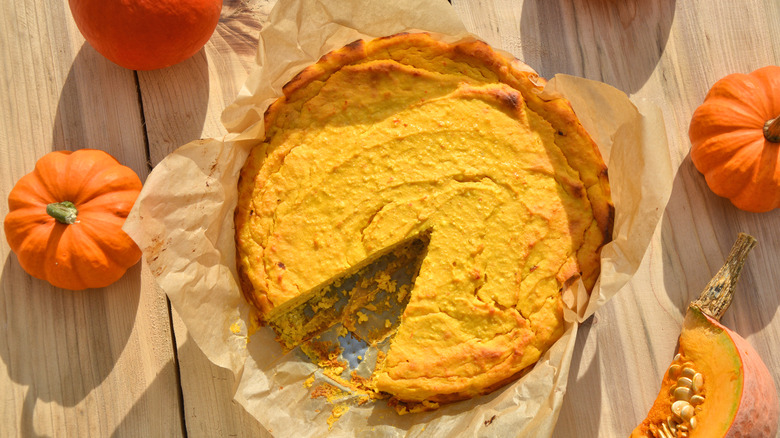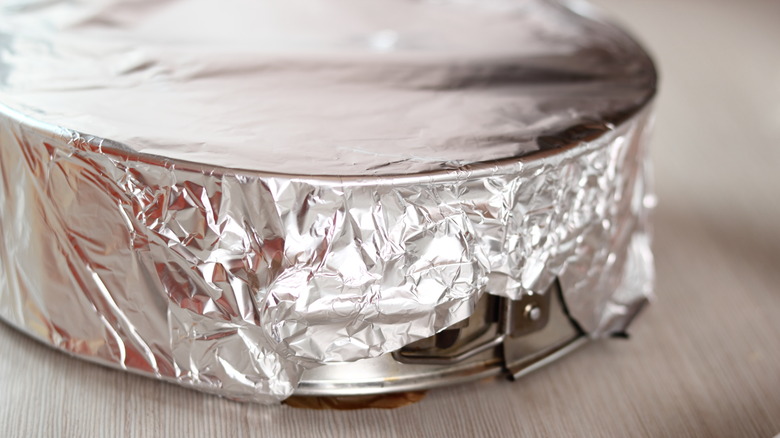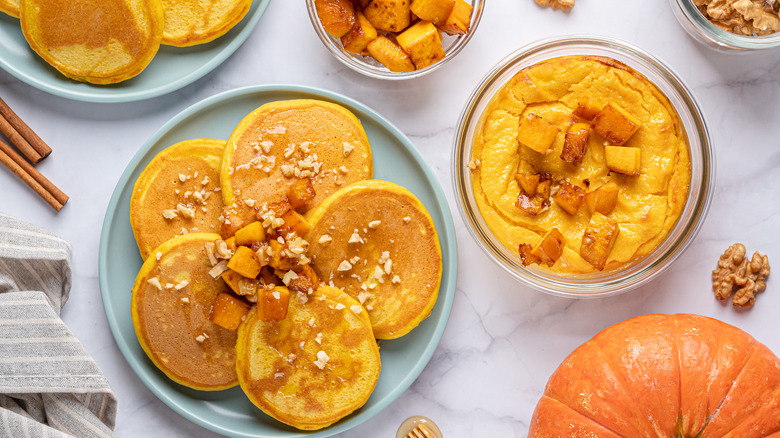Yes, You Can Absolutely Freeze A Pumpkin Cheesecake
With its sweet flavor and vibrant color, pumpkin is the star of the fall season. You can use it as a decoration, turn it into a pie, or incorporate it into desserts and savory dishes, from soups and risottos to brownies. One cup of cooked pumpkin has roughly 50 calories and 12 grams of carbs, so it fits most diets. You'll also get around 3 grams of fiber, 25% of the recommended daily copper intake, and large doses of iron, potassium, vitamin A, and vitamin E. Moreover, this superfood has a relatively long shelf-life and can last up to three months in the pantry.
Things are a bit different when it comes to pumpkin desserts. For example, pumpkin cheesecake is made with butter, eggs, cream cheese, and other ingredients that can spoil quickly. Therefore, you'll need to either refrigerate or freeze it if you don't plan to eat it right away. Most cheesecakes can be stored in the fridge for five to seven days, but you can also freeze them for three to six months, depending on the ingredients used.
Pumpkin cheesecake freezes quite well and can be stored whole or sliced. The key is to wrap it tightly in foil without ruining its shape.
How to freeze a pumpkin cheesecake
This creamy dessert holds well in the freezer, but you'll need to do some prep work to maintain its shape and texture. First, let it cool on the table or countertop. After that, place it in the fridge for two or three hours until it's set. If you want to freeze a whole pumpkin cheesecake, transfer it to a plate and wrap it in a layer of plastic wrap or heavy-duty aluminum foil. Add a second layer of foil for extra protection. The whole point is to keep the air out and prevent freezer burn.
Another option is to freeze individual slices so you can enjoy them one at a time. Start by placing the slices in a single layer on a baking sheet lined with wax paper, leaving ½ inch to 1 inch in between. Freeze them until firm, then wrap each slice in two layers of plastic wrap and foil. Transfer them to an airtight container, label them with the date, and store them in the freezer for three months or so.
When you're ready to eat the cheesecake, simply thaw it in the refrigerator overnight. Note that whipped cream, caramel sauce, lemon meringue, and other toppings don't freeze well. Ideally, add them to the cheesecake after thawing it. Serve it over the next few days, and get creative with the leftovers.
What to do with leftover cheesecake
Generally, it's not a good idea to refreeze a pumpkin cheesecake — or any cheesecake, for that matter. Repeated freezing and thawing can make the cake dry or soggy and promote microbial growth. Given these aspects, it's best to repurpose the leftovers into other desserts, such as truffles, parfaits, or even ice cream. For example, you can blend leftover cheesecake with vanilla ice cream, milk, and pumpkin spice for a creamy beverage or add crumbled cheesecake to pancake batter for a breakfast treat.
Craving tiramisu? Use pumpkin cheesecake instead of ladyfingers for a fall-flavored twist. This dessert can also double as a filling for matcha crepes, Bundt chocolate cakes, or chocolate balls. If you're feeling creative, eschew the flapjacks and fold chunks of cheesecake into muffin batter to surprise your guests. Alternatively, try leftover cheesecake as a topping for sundaes, fruit salads, or waffles.
The leftovers can also add flavor to brownies and breakfast foods like French toast. For instance, you can place a slice of cheesecake between two pieces of bread, dip the dessert sandwich in a mixture of eggs, sugar, and spices, and fry until crispy. For a hearty, slightly more nutritious breakfast, cut the cheesecake into small pieces and mix them into your morning oatmeal. Sprinkle a dash of cinnamon on top to give it a spicy kick.


